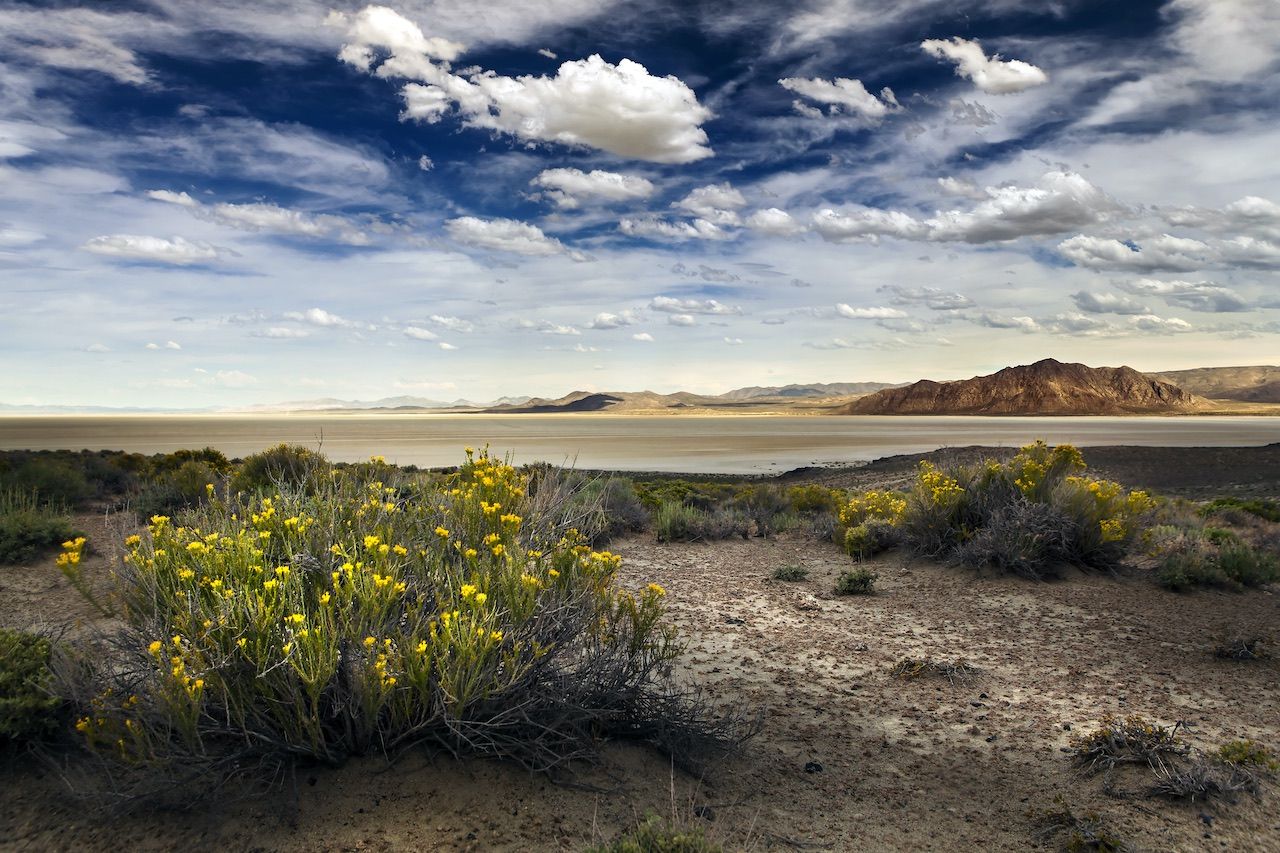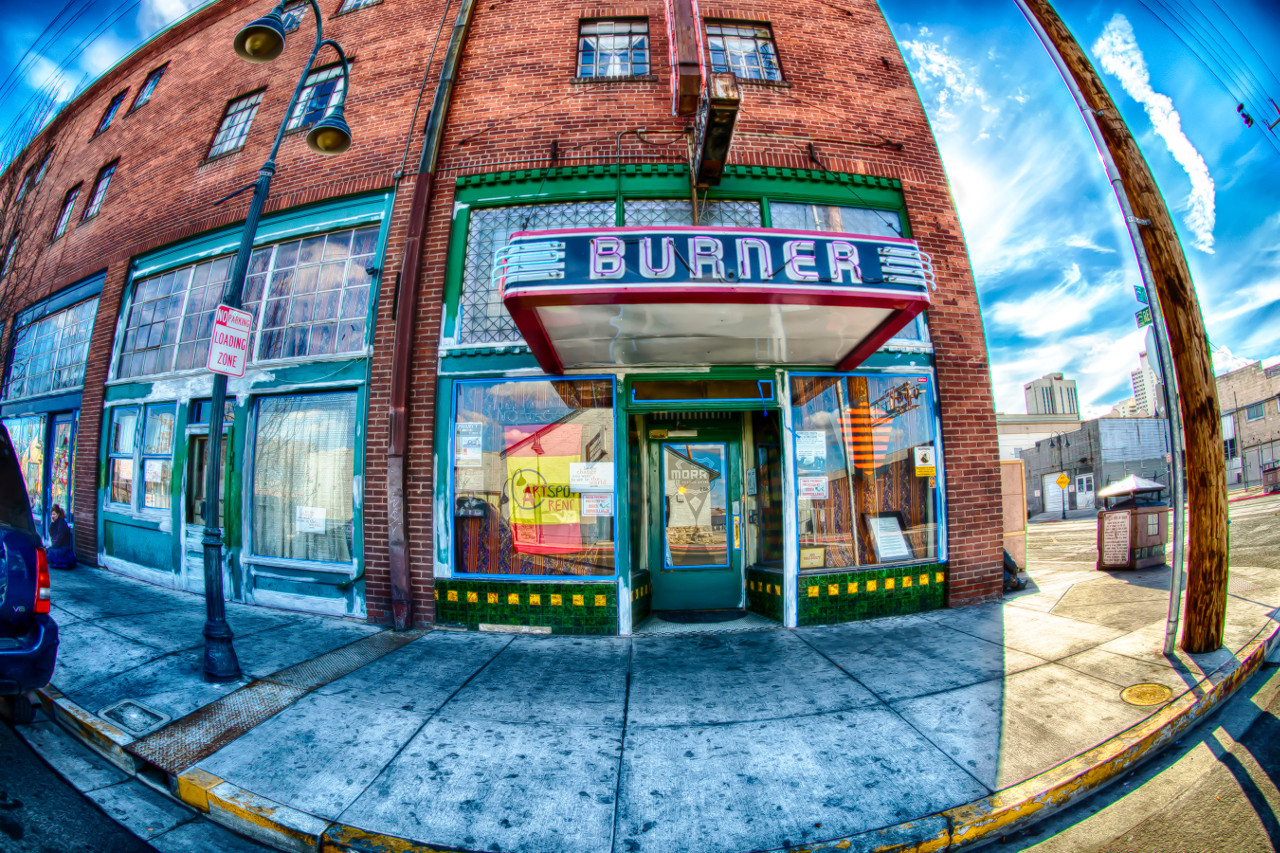BURNING MAN BURSTS INTO BEING like divine fire in the middle of Black Rock for a week, and then it’s gone. Since the festival migrated from San Francisco to the Black Rock Desert Wilderness in 1990, the vast playa has shaped the experience as much as the flaming art and organizers do. For much of the year just another beautiful and desolate expanse of Nevada, the very emptiness of Black Rock’s otherworldly landscape is part of what allows Burning Man to erupt into a 60,000-person “city” each year.
But the symbiotic dance of human creativity and the extremes of nature can be found in all corners of Nevada, not just for a week at Burning Man. Here are 9 places to celebrate its spirit year round.
1. Black Rock Desert Wilderness

Photo: Shutterstock/Neil Lockhart
The 300,000-acre ancient-lakebed-turned-arid-desert that serves as the canvas for Burning Man can be experienced any time of year. Drive out to the conservation area and take in the playa from the comfort of your lawn chair. Known for its powder-fine dust and whiteout storms, the playa in the summer months can be a brutally hot and harsh place. Spend a few minutes under the mid-afternoon sun and you start to wonder at the sanity of willfully setting up camp here for a week.
Still, the extreme nature of the place is part of what gives Burning Man its immediacy and boundary-pushing qualities. And camping on the flat, open playa of the Black Rock Desert is an especially incredible experience.
2. Rhyolite and the Goldwell Open Air Museum
A few miles from Beatty and spitting distance from Death Valley lies the ghost town of Rhyolite. A hundred years have stripped the meat from the bones of this mining boom town, and now the few walls that stand attract a steady trickle of curious visitors. The most preserved and interesting site is the Bottle House, a small structure chiefly composed of 50,000 glass bottles, demonstrating a strong streak of junkyard ingenuity that you’ll see all over these desert parts. Self-reliance is a central tenet of the Burning Man ethos, and the Bottle House, built by Tom Kelley, presaged this festival doctrine.
Standing slightly apart from the Rhyolite ruins are a gathering of shrouded figures. Approach and you’ll see that the illusion of personage is created by the negative space around a plaster “shroud.” This is the central piece of the Goldwell Open Air Museum, an impressive, ominous, and beautiful sight in the last moments of sunset. Art dominates the environment at Burning Man, and encountering art “where it shouldn’t be,” in the middle of a desert, is a fundamental aspect of the experience both there and here in Goldwell.
3. Morris Burner Hotel

Photo: Morris Burner Hotel
Burning Man enthusiast Jim Gibson purchased an 80-year-old hotel in downtown Reno and transformed it into a Burning Man-inspired, membership-based hotel and arts space. While technically a private club, the hotel has 16 themed rooms and membership ranges from $5/month to $1,000/year, or you can just pay $20 for a one-month membership. Themed rooms include the Goddess Room, Forest Lord Room, and Sparkle Pony Room. From the Morris mission statement:
The Morris Burner Hotel is a Burning Man-inspired housing facility and community space dedicated to building community, fostering the arts, and helping to educate people in the Burning Man ethos.
4. Double Negative
A giant land sculpture by Michael Heizer, Double Negative is one of the first works of a movement known as “land art” or “earth art.” Essentially, it consists of removed earth in the form of two enormous trenches — 1,500 feet long altogether — aligned on the natural curve of a mesa. The sheer size of the piece calls to mind the ancient earth art of civilizations past, and the artwork itself could indeed outlast our little moment in history and take its place among the mysterious monuments of old. Created between ’69-’70, Double Negative foreshadows the Burning Man traditions of radical self-expression and interacting with massive natural environments in the Nevada desert.
Double Negative is owned by The Museum of Contemporary Art, Los Angeles, and can be visited by those equipped with 4WD and a good pair of hiking boots. Detailed instructions are found here.
5. Goldfield
Goldfield is one weird place, and I mean that in the best way possible. Like a little slice of Burning Man in the form of an eccentric ghost town that still maintains a small population and a limbo-like existence, Goldfield is also home to a small fleet of art cars — they’ve been to BM and are easily spotted on the main road through town. The cars are bizarre, complex, dirty, and mesmerizing in an apocalyptic sort of way. When I showed up and started poking my head around, a duo of local guys in their 50s appeared to share the lore and appropriate Google search words for more info on the cars, created by a man named Rocket Bob.
The rest of Goldfield seems to take its cues from Rocket Bob’s cars. Found-object decorations dominate the dusty aesthetic. Wandering around, you don’t necessarily know what’s derelict and what isn’t, whether a buildings is occupied or not, what is garbage and what is…art? Like Burning Man, Goldfield avoids definition and blurs the lines between past and present, real and imagined.
6. International Car Forest and Last Church
Nose first in the dirt like an unexploded missile, the rusted-out school bus shines weakly in the harsh sun. The bus is set apart from the main cluster of cars, also inserted grill first into the ground. A Mad Max Stonehenge, the ruined vehicles have a bizarre monolithic quality, like desert druids at the end of the world are preparing their last rites…yeah, this place is weird. Dozens of cars at obtuse angles. The hoods decorated by various artists. There’s a sun-faded Ron Paul caricature as well as skulls, geese, and a unicorn.
To find the International Car Forest, drive into Goldfield and ask a local. I was chatting with the guys who hang around the art cars and they gave me the simple directions. If you can’t find anyone, head to the gift shop. You can actually see the Car Forest from the highway coming into town, but because the dirt road leading to it is unmarked and one among many such roads, it may not be immediately obvious. The land is private, but apparently visitors may enter freely.
7. Forgotten City: Las Vegas Regional Burn
The official Las Vegas Regional Burning Man event, Forgotten City, is an 800-person mini-burn over Memorial Day weekend (May 22-25, 2015). Set mere miles from Las Vegas, think of it as a warmup to the main event. Tickets are $75 and on sale now.
8. Reno Decompression
Every year, many major cities hold post-Burning Man “decompression” events, and the Reno burner community represents by throwing a huge party each fall. Decompressions are a way for burners to reignite the fire they left on the playa and bring the Burning Man spirit further into the “real world.” For news and info, check the Reno Decomp website closer to the event date of October 17, 2015.
9. The Generator
Part workshop, part art space — all are welcome at The Generator to lend a hand, get creative, and contribute to projects bound for Burning Man. Based in greater Reno, The Generator houses a vast array of tools and has space available for resident artists. From the Generator website:
The Generator is an oasis of decommodification. We don’t buy. We don’t sell. We dream. We convene. We create. We make. We’re inspired by the magic and inspiration we see in all its enormity at Burning Man each summer, and we want to keep it alive all year.
Come do your part to keep the spirit alive.

